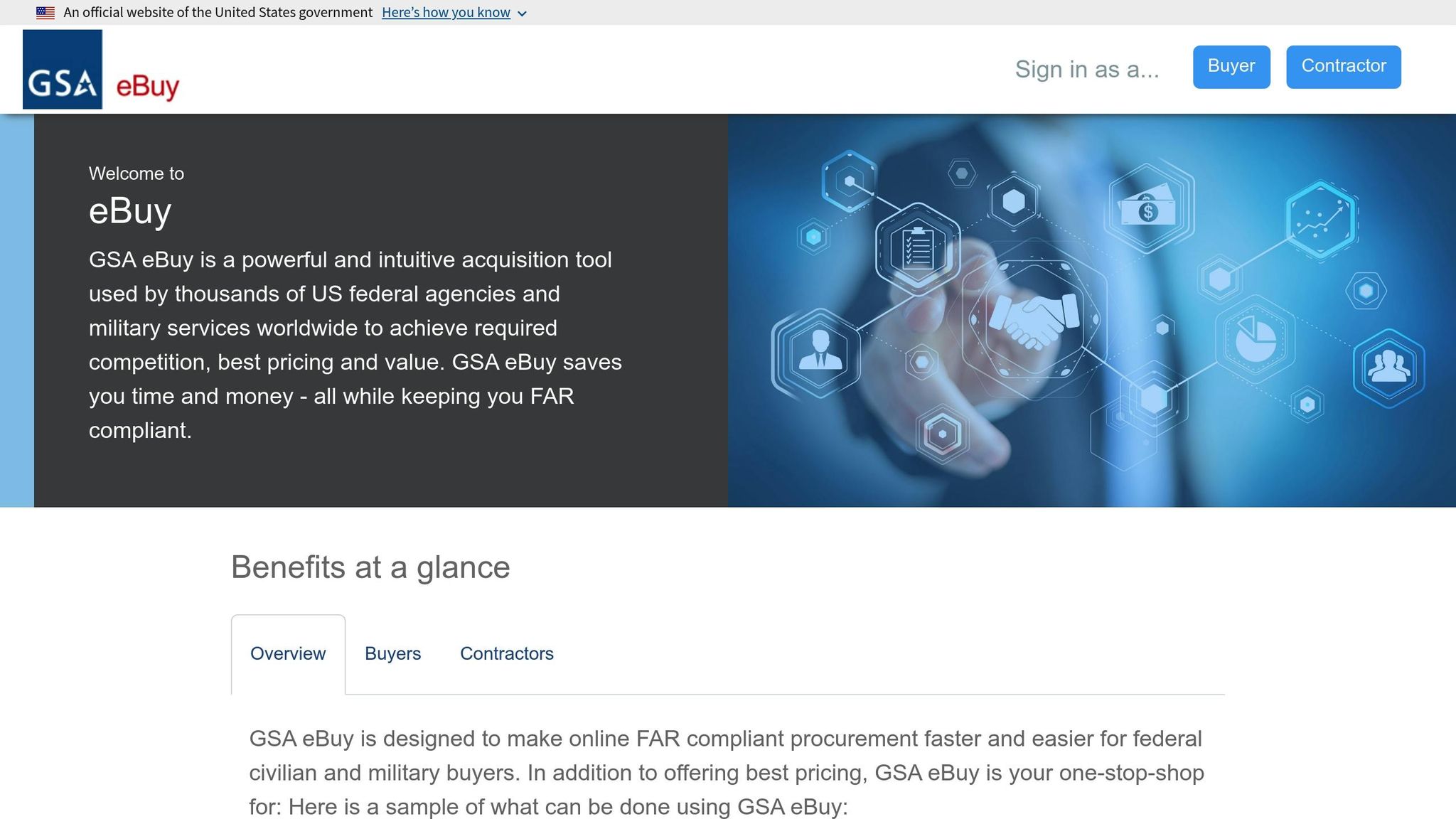- Federal Market Opportunity: In 2023, $45 billion flowed through GSA Schedule contracts, with over $160 million available daily.
- Low Competition: Only 4% of small businesses hold GSA contracts, and 44% of awards receive just one bid.
- Big Rewards: GSA participants often see an average revenue increase of $927,000 annually.
Steps to Get Started:
- Check Eligibility: Register in SAM, secure a DUNS number, and prove financial stability.
- Prepare Documents: Financial statements, past performance records, and technical capabilities are essential.
- Set Pricing: Research market rates, account for costs, and offer competitive discounts.
- Submit Proposal: Use GSA’s eOffer system and work closely with contracting officers.
- Optimize Your Profile: Enhance your GSA Advantage listing and leverage GSA eBuy for opportunities.
Pro Tip: Strong federal connections and compliance are key to long-term success.
This guide simplifies the process and helps you tap into the lucrative federal marketplace. Let’s dive into the details!
GSA Schedules – Top To Bottom – Get On The GSA Schedule
1. Meeting GSA Schedule Requirements
Before jumping into the GSA Schedule application process, small businesses need to tick off a few crucial boxes. Proper preparation and attention to detail can help avoid unnecessary delays or even rejection.
1.1 Confirming Basic Eligibility
First things first: make sure your business meets the eligibility criteria. This typically involves having an active registration in the System for Award Management (SAM) and a valid DUNS number. Beyond that, you’ll need to show proof of financial stability and a solid track record of past performance.
1.2 Required Documentation Checklist
Here’s a breakdown of the key documents you’ll need to gather:
-
Financial Documentation
Include financial statements and tax returns to showcase your business’s financial health. -
Past Performance Records
Collect documents that highlight your previous work, such as:- Client testimonials
- Project completion certificates
- Performance evaluations
- Contract award documents
-
Technical Capabilities
Prepare detailed descriptions of your:- Service offerings
- Quality control processes
- Staff qualifications
- Facility certifications
1.3 Setting GSA Contract Prices
Pricing is a make-or-break factor for securing a GSA Schedule contract. Your strategy should strike a balance between staying competitive in the market and maintaining healthy profit margins. Here’s a quick guide to pricing considerations:
| Pricing Factor | Approach |
|---|---|
| Market Research | Use platforms like GSA Advantage to analyze competitors’ pricing. |
| Cost Analysis | Account for both direct and indirect costs. |
| Profit Margins | Set margins that ensure long-term sustainability. |
| Volume Discounts | Offer tiered pricing for bulk orders. |
The secret to getting your pricing right lies in thorough market research and knowing your cost structure inside out. Platforms like GSA eBuy and GSA Advantage can help you gauge market rates and competitor pricing. Keep in mind that only 4% of small businesses currently hold GSA Schedule contracts, which underscores both the opportunity and the challenges involved.
2. Submitting and Negotiating Your GSA Schedule
Once you’ve established eligibility and set competitive pricing, the next step is submitting a solid proposal and navigating negotiations effectively.
2.1 Writing Your Technical Proposal
Your technical proposal needs to align with the requirements for the Special Item Numbers (SINs) you’re targeting. Use the GSA eLibrary to ensure your submission meets current specifications and standards.
Make sure to include these key elements:
- A capability statement outlining your expertise.
- Quality control procedures to demonstrate reliability.
- Staff qualifications that highlight your team’s skills.
- Project management methods to show how you handle tasks effectively.
If you’re submitting for IT services under Category 70, ensure compliance with NIST SP 800-145 cloud security standards. For Help Desk Services (SIN 541511HD), your proposal should reflect capabilities that align with market rates, which averaged $142.50/hour in 2024.
2.2 Creating Your Price Proposal
Your Price Proposal Template (PPT) is a critical part of your submission. Here’s what it should include:
| Component | Requirement | Documentation Needed |
|---|---|---|
| Commercial Pricing | Reflect current rates | 5 matching client invoices |
| Volume Discounts | Tiered structure | Discount breakdowns |
| Cost Basis | Direct/indirect costs | Detailed cost calculations |
| Price Adjustments | Annual increases | Market justification |
Consider tiered discounts to make your pricing more competitive:
- 3% for orders over $25,000
- 5% for orders over $50,000
- 7% for orders over $100,000
On average, successful GSA Schedule contracts offer discounts between 12–18% below commercial rates.
2.3 Working with GSA Contracting Officers
Strong communication with GSA Contracting Officers is essential during the negotiation phase. Data shows that 68% of proposals require revisions during the review process, so being responsive and thorough is crucial.
Here are tips for handling clarification requests:
- Document Everything: Keep detailed, timestamped logs of all negotiations.
- Justify Your Pricing: Use up-to-date market data and invoices to support your proposed rates.
- Leverage the TDR Program: Participating in the Transactional Data Reporting (TDR) program can reduce negotiation time by 35% compared to the traditional Most Favored Customer method. Just remember, TDR participants must submit quarterly reports within 15 days to avoid an automatic 2% price reduction.
For new contractors, requesting an Introductory Contract Review within the first 90 days can help you avoid compliance mistakes and establish a strong foundation for contract management.
Keep in mind that all submissions must now go through GSA’s eOffer system, which handles 92% of contracts electronically. While this system has sped up the process, expect the overall review to take 6–12 months.
3. Making the Most of Your GSA Schedule
3.1 Setting Up GSA Advantage

Having a strong presence on GSA Advantage is key to tapping into federal contracting opportunities. A well-prepared profile can make all the difference.
Here’s how to enhance your visibility on GSA Advantage:
- Catalog Setup: Ensure your product and service listings are detailed and accurate. Include NAICS codes, SINs, socioeconomic designations, and contract-specific pricing. These details help federal buyers find exactly what they need.
- Keyword Optimization: Use keywords that align with both industry standards and specific agency needs. This improves your chances of appearing in relevant search results.
- Price Management: Keep your pricing up to date, reflecting any discounts, promotions, or contract modifications. A current catalog signals reliability to potential buyers.
A polished and regularly updated GSA Advantage profile can significantly boost your appeal to federal buyers. If you’re unsure where to start, professional services like those offered by GSA Focus can guide you through the process.
Once your profile is ready, don’t stop there – use GSA eBuy to explore additional opportunities.
3.2 Finding Opportunities on GSA eBuy

GSA eBuy is a powerful tool for uncovering new business prospects, often with less competition than traditional bidding processes.
- Monitor RFQs: Set up automated alerts for relevant SINs to stay on top of new opportunities. Pay special attention to RFQs that include small business set-asides or have straightforward technical requirements.
- Proposal Development: Craft proposals that highlight your strengths. Emphasize past performance, technical expertise, competitive pricing, and what makes your offerings stand out.
By staying proactive on GSA eBuy, you can position your business to win more contracts.
3.3 Connecting with Federal Buyers
While optimizing your profile and responding to bids are important, building direct relationships with federal buyers is the final piece of the puzzle. Strong connections can open doors to new opportunities and long-term partnerships.
Here are some ways to engage with federal buyers effectively:
| Engagement Method | Key Activities | Expected Outcomes |
|---|---|---|
| Direct Outreach | Share customized capability statements tailored to specific agencies | Greater visibility |
| Networking | Attend industry days and procurement events to meet buyers face-to-face | Stronger personal connections |
| Digital Presence | Keep your GSA Advantage profile updated regularly | Improved searchability |
| Past Performance | Highlight and share documented success stories from previous contracts | Better positioning for bids |
Success in federal contracting often comes down to building trust and maintaining strong relationships. Keep an eye on metrics like your GSA sales volume, bid response rates, agency feedback, and win rates to measure your progress. With only 4% of small businesses utilizing GSA Schedules, those who actively engage with agencies have a clear advantage.
sbb-itb-8737801
4. Managing Your GSA Schedule
4.1 Meeting Compliance Requirements
Staying compliant with your GSA Schedule requires meticulous record-keeping and a sharp eye for detail. Josh Ladick, Founder of GSA Focus, perfectly captures the challenge:
"Dealing with compliance… Hiring lawyers, googling 1,000 things a day, etc." – Josh Ladick
To stay on track, it’s crucial to regularly review and update your records to meet ongoing compliance standards.
4.2 Updating Your GSA Schedule
Keeping your GSA Schedule up-to-date is not just a good practice – it’s a necessity. Regularly reviewing your documentation and certifications ensures your contract remains competitive and compliant. If navigating these updates feels overwhelming, expert assistance can make all the difference. For instance, GSA Focus offers full-service compliance support to help you manage these updates efficiently.
4.3 Working with Subcontractors
Managing subcontractors effectively is another essential aspect of maintaining your GSA Schedule. These partnerships can significantly expand your ability to serve federal agencies. To ensure everything runs smoothly, establish clear processes and document all agreements. This not only strengthens your operational capacity but also ensures you stay aligned with federal compliance requirements.
5. Growing Your Federal Business
Once you’ve established your GSA Schedule, it’s time to focus on expanding your presence in the federal marketplace. Success here depends on showcasing your track record and building strategic relationships.
5.1 Using Contract Performance Records
In the federal sector, a strong performance record isn’t just helpful – it’s essential. Agencies prioritize vendors who can demonstrate reliability and efficiency. Carefully document your successes, including cost savings, timely project completions, and any other measurable achievements. These records don’t just highlight your past performance; they also serve as proof that you’re ready to handle larger, more complex federal contracts. The better your track record, the stronger your position when pursuing new opportunities.
5.2 Moving to Larger Federal Contracts
Once your GSA Schedule is in place, it’s time to aim higher. The numbers speak for themselves: in 2023, the GSA Schedule program facilitated $45 billion in transactions. Use your proven success to qualify for larger contracts, and continue delivering exceptional results to open the door to even bigger deals. As you scale up, building solid federal connections becomes even more critical to sustaining growth.
5.3 Building Federal Connections
Relationships are the backbone of long-term success in federal contracting. Attend industry events, vendor days, and connect with OSDBU representatives and federal contractor associations. These interactions aren’t just networking opportunities – they’re a chance to establish partnerships that can lead to consistent revenue streams.
"Dealing with compliance… Hiring lawyers, googling 1,000 things a day, etc." – Josh Ladick
Active engagement and relationship-building can make a significant difference in your ability to secure and sustain federal contracts.
Conclusion: Next Steps for Your GSA Schedule
Securing and managing a GSA Schedule doesn’t have to feel overwhelming. With the right strategy, you can tap into the vast opportunities within the federal marketplace, where competition is often less fierce than expected.
Having expert guidance can make all the difference, helping you sidestep common pitfalls and fast-track your success.
"We guarantee your success with the GSA Program, or you don’t pay a cent." – Josh Ladick, President and Founder, GSA Focus
Here are three essential areas to focus on:
- Documentation and Compliance: Navigating the paperwork and meeting federal requirements can be daunting. A professional GSA service ensures your documentation is in order, reducing the risk of compliance issues and maintaining your schedule.
- Strategic Pricing: Setting the right pricing structure is key. GSA experts can help you find the balance between profitability and staying competitive in the federal marketplace, which is critical for long-term success.
- Systems Integration: Platforms like GSA eBuy and GSA Advantage are vital tools for federal contracting. Proper setup and integration, with expert assistance, ensure you’re ready to seize opportunities through these systems.
By building on these pillars – compliance, pricing, and systems integration – you’ll position your business for success in the federal contracting space.
The federal marketplace holds tremendous potential for growth, especially for small businesses ready to take action. With a clear plan and the right support, you can join the ranks of successful GSA Schedule holders and start capturing valuable federal opportunities.
FAQs
What are the main eligibility criteria for small businesses to qualify for a GSA Schedule award?
To be eligible for a GSA Schedule award, small businesses need to meet several important criteria. First, your business must have been operating for at least two years and show that it is financially stable. This means providing financial statements that prove your company can handle the responsibilities of federal contracts.
Your business also needs a solid history of delivering high-quality products or services. This often involves presenting evidence of past performance, such as references or records of previous contracts (including subcontracting work), to demonstrate your reliability and capability.
Lastly, you must comply with all federal regulations and complete the necessary registrations. This includes obtaining a DUNS number and registering in the System for Award Management (SAM). By meeting these requirements, your business will be well-prepared to pursue a GSA Schedule award successfully.
What strategies can small businesses use to set competitive pricing for their GSA Schedule proposals?
Setting pricing for your GSA Schedule proposal takes a mix of careful research, thoughtful strategy, and a deep understanding of your market. A good starting point is to explore pricing data on GSA Advantage. This resource gives you a clear picture of what similar companies are charging for comparable products or services, helping you pinpoint a reasonable price range.
Next, take a close look at your own costs and profit margins. Your pricing should not only appeal to federal buyers but also be sustainable for your business in the long run. If your business offers something extra – like outstanding customer service or specialized skills – make sure to emphasize those strengths as part of your pricing rationale.
Remember, pricing isn’t just about undercutting competitors. It’s about finding the right balance between cost and quality to deliver real value to government agencies.
How can small businesses increase their visibility and win more opportunities using GSA Advantage and GSA eBuy?
To improve your presence and success on GSA Advantage and GSA eBuy, start by making sure your product or service listings are thorough, accurate, and appealing. Use clear, concise descriptions, include relevant keywords, and upload high-quality images to grab attention. Pricing is another critical factor – research market trends and federal spending data to position your offerings competitively.
For GSA eBuy, keep a close eye on opportunities and respond quickly to RFQs (Requests for Quotations). Craft tailored proposals that emphasize what sets your business apart. Building strong connections with federal agencies is equally important. Consider targeted marketing, attending government contracting events, and showcasing your past performance to build trust and credibility. These strategies can help you stand out and win more federal contracts.
Related posts
- GSA Award Process Explained
- Top 7 GSA Schedule Benefits for Small Businesses
- How to Access GSA Small Business Support Programs
- How a GSA Federal Contract Can Transform Your Small Business


